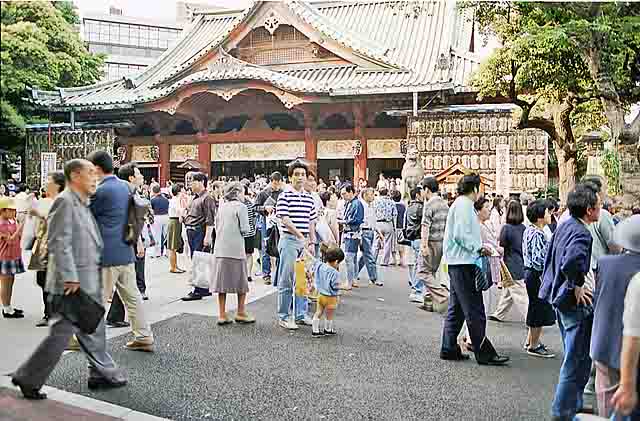|
Sada Abe
was a Empire of Japan, Japanese geisha and prostitute who murdered her lover, , via strangulation on May 18, 1936, before cutting off his Human penis, penis and testicles and carrying them around with her in her kimono. The story became a national sensation in Japan, acquiring mythic overtones, and has been interpreted by artists, philosophers, novelists and filmmakers. Abe was released after serving five years in prison and went on to write an autobiography. Family background Sada Abe was the seventh of eight children of Shigeyoshi and Katsu Abe, an upper middle-class family of tatami, tatami mat makers in Tokyo's Kanda, Tokyo, Kanda neighborhood. Only four of the Abe children survived to adulthood, and of those Sada was the youngest. Sada's father, originally from Chiba Prefecture, had been adopted into the Abe family to help with the business, which he eventually inherited. Aged 52 at the time of Sada's birth, Shigeyoshi Abe was described by police as "an honest and upright m ... [...More Info...] [...Related Items...] OR: [Wikipedia] [Google] [Baidu] |
Kanda, Tokyo
is an area in northeastern Chiyoda, Tokyo, Japan. It encompasses about thirty neighborhoods. Kanda was a ward prior to 1947. When the 35 wards of Tokyo were reorganized into 23, it was merged with Kojimachi to form the modern Chiyoda. Kanda, together with Nihonbashi and Kyobashi, is the core of Shitamachi, the original downtown center of Edo-Tokyo, before the rise of newer secondary centers such as Shinjuku and Shibuya. It is home to the Kanda Myojin (Shinto) shrine, devoted to the ancient rebel Taira no Masakado, who led an uprising against the central government during the Heian period with the aim of establishing himself as "Shinnō" (New Emperor) of an eastern Court. In the Edo period, the shrine's festival was one of the three most famous in the city. It is also home to the "Mausoleum of Confucius at Yushima", a temple dedicated to Confucianism. Kanda is the home of the Tokyo Resurrection Cathedral which was built by Nicholas of Japan and is the main Cathedral of t ... [...More Info...] [...Related Items...] OR: [Wikipedia] [Google] [Baidu] |
Rape
Rape is a type of sexual assault usually involving sexual intercourse or other forms of sexual penetration carried out against a person without their consent. The act may be carried out by physical force, coercion, abuse of authority, or against a person who is incapable of giving valid consent, such as one who is unconscious, incapacitated, has an intellectual disability, or is below the legal age of consent. The term ''rape'' is sometimes used interchangeably with the term ''sexual assault.'' The rate of reporting, prosecuting and convicting for rape varies between jurisdictions. Internationally, the incidence of rapes recorded by the police during 2008 ranged, per 100,000 people, from 0.2 in Azerbaijan to 92.9 in Botswana with 6.3 in Lithuania as the median. [...More Info...] [...Related Items...] OR: [Wikipedia] [Google] [Baidu] |
Nakano, Tokyo
Nakano ( ja, 中野, Latn, ja, Nakano) is a special ward in Tokyo, Japan. The English translation of its Japanese self-designation is Nakano City (, Latn, ja, Nakano-ku).About Nakano City " Retrieved March 10, 2013. As of May 1, 2015, the ward has an estimated population of 322,731, and a population density of 20,701 persons per km2. The total area is 15.59 km2. Nakano is the most densely populated city in Japan. History The ward was founded on October 1, 1932, when the towns of Nogata and Nakano were absorbed into the former as Nakano Ward. The present administration dates from March 15, 1947, wh ...[...More Info...] [...Related Items...] OR: [Wikipedia] [Google] [Baidu] |
Kusatsu, Gunma
250px, Kusatsu town hall is a town located in Gunma Prefecture, Japan. , the town had an estimated population of 6,255 in 3407 households, and a population density of 130 persons per km2. The total area of the town is . Kusatsu is one of the most famous hot springs resorts in Japan. Geography Kusatsu is situated about 1,200 meters above sea level. The active volcano Kusatsu-Shirane (2,160 m) and the inactive Mount Tengu (1,385 m) and Mount Motoshirane (2,171 m) are located west of Kusatsu. Surrounding municipalities Gunma Prefecture * Higashiagatsuma * Tsumagoi * Nakanojō Nagano Prefecture * Takayama Climate Kusatsu has a Humid continental climate (Köppen ''Dfb'') characterized by warm summers and cold winters with heavy snowfall. The average annual temperature in Kusatsu is 3.3 °C. The average annual rainfall is 1711 mm with September as the wettest month. The temperatures are highest on average in August, at around 23.7 °C, and lowest in January, a ... [...More Info...] [...Related Items...] OR: [Wikipedia] [Google] [Baidu] |
Diet Of Japan
The is the national legislature of Japan. It is composed of a lower house, called the House of Representatives (, ''Shūgiin''), and an upper house, the House of Councillors (, '' Sangiin''). Both houses are directly elected under a parallel voting system. In addition to passing laws, the Diet is formally responsible for nominating the Prime Minister. The Diet was first established as the Imperial Diet in 1890 under the Meiji Constitution, and took its current form in 1947 upon the adoption of the post-war constitution. Both houses meet in the in Nagatachō, Chiyoda, Tokyo. Composition The houses of the National Diet are both elected under parallel voting systems. This means that the seats to be filled in any given election are divided into two groups, each elected by a different method; the main difference between the houses is in the sizes of the two groups and how they are elected. Voters are also asked to cast two votes: one for an individual candidate in a const ... [...More Info...] [...Related Items...] OR: [Wikipedia] [Google] [Baidu] |
Nagoya
is the largest city in the Chūbu region, the fourth-most populous city and third most populous urban area in Japan, with a population of 2.3million in 2020. Located on the Pacific coast in central Honshu, it is the capital and the most populous city of Aichi Prefecture, and is one of Japan's major ports along with those of Tokyo, Osaka, Kobe, Yokohama, and Chiba. It is the principal city of the Chūkyō metropolitan area, which is the third-most populous metropolitan area in Japan with a population of 10.11million in 2020. In 1610, the warlord Tokugawa Ieyasu, a retainer of Oda Nobunaga, moved the capital of Owari Province from Kiyosu to Nagoya. This period saw the renovation of Nagoya Castle. The arrival of the 20th century brought a convergence of economic factors that fueled rapid growth in Nagoya, during the Meiji Restoration, and became a major industrial hub for Japan. The traditional manufactures of timepieces, bicycles, and sewing machines were followed by th ... [...More Info...] [...Related Items...] OR: [Wikipedia] [Google] [Baidu] |
Deposition (law)
A deposition in the law of the United States, or examination for discovery in the law of Canada, involves the taking of sworn, out-of-court oral testimony of a witness that may be reduced to a written transcript for later use in court or for discovery purposes. Depositions are commonly used in litigation in the United States and Canada. They are almost always conducted outside court by the lawyers themselves, with no judge present to supervise the examination. History Depositions by written interrogatories first appeared around the mid-15th century as a procedure for discovery, factfinding, and evidence preservation in suits in equity in English courts. Available through HeinOnline. They differed radically from modern depositions in three ways: (1) the party seeking a witness's testimony merely propounded written interrogatories which were read out loud by a master or court-appointed commissioner to the witness in a closed proceeding without parties or counsel present; (2) the w ... [...More Info...] [...Related Items...] OR: [Wikipedia] [Google] [Baidu] |
Tobita Shinchi
, also known as , is the largest of the brothel districts in Osaka, and also the largest in western Japan. It is located in the Sanno 3-chōme area of Nishinari-ku, Osaka. Tobita Shinchi dates from the Taishō period. To circumvent the anti-prostitution laws, the brothels operate largely under the guise of being "Japanese-style restaurants" (Ryoutei). Overview The area consists of three main streets: Youth Street (青春通り Seishun Doori), Main Street (メイン通り Mein Doori) and Big Gate Street (大門通り Ohmon Doori). Tobita brothels, similar to how brothels in Amsterdam have women in the windows, tend to have a young woman kneeling by the genkan (entryway) or in the living room (which is fully open to the street) of the brothel to attract customers—an unusual practice for brothels in Japan. Often the women are dressed as schoolgirl or nurse costumes. Most of the prostitutes are Japanese, although there are some zainichi (Koreans). An elderly woman called the 'Yari ... [...More Info...] [...Related Items...] OR: [Wikipedia] [Google] [Baidu] |
Osaka
is a designated city in the Kansai region of Honshu in Japan. It is the capital of and most populous city in Osaka Prefecture, and the third most populous city in Japan, following Special wards of Tokyo and Yokohama. With a population of 2.7 million in the 2020 census, it is also the largest component of the Keihanshin Metropolitan Area, which is the second-largest metropolitan area in Japan and the 10th largest urban area in the world with more than 19 million inhabitants. Osaka was traditionally considered Japan's economic hub. By the Kofun period (300–538) it had developed into an important regional port, and in the 7th and 8th centuries, it served briefly as the imperial capital. Osaka continued to flourish during the Edo period (1603–1867) and became known as a center of Japanese culture. Following the Meiji Restoration, Osaka greatly expanded in size and underwent rapid industrialization. In 1889, Osaka was officially established as a municipality. The construc ... [...More Info...] [...Related Items...] OR: [Wikipedia] [Google] [Baidu] |
Syphilis
Syphilis () is a sexually transmitted infection caused by the bacterium ''Treponema pallidum'' subspecies ''pallidum''. The signs and symptoms of syphilis vary depending in which of the four stages it presents (primary, secondary, latent, and tertiary). The primary stage classically presents with a single chancre (a firm, painless, non-itchy skin ulceration usually between 1 cm and 2 cm in diameter) though there may be multiple sores. In secondary syphilis, a diffuse rash occurs, which frequently involves the palms of the hands and soles of the feet. There may also be sores in the mouth or vagina. In latent syphilis, which can last for years, there are few or no symptoms. In tertiary syphilis, there are gummas (soft, non-cancerous growths), neurological problems, or heart symptoms. Syphilis has been known as "the great imitator" as it may cause symptoms similar to many other diseases. Syphilis is most commonly spread through sexual activity. It may also be transmi ... [...More Info...] [...Related Items...] OR: [Wikipedia] [Google] [Baidu] |
Yokohama
is the second-largest city in Japan by population and the most populous municipality of Japan. It is the capital city and the most populous city in Kanagawa Prefecture, with a 2020 population of 3.8 million. It lies on Tokyo Bay, south of Tokyo, in the Kantō region of the main island of Honshu. Yokohama is also the major economic, cultural, and commercial hub of the Greater Tokyo Area along the Keihin region, Keihin Industrial Zone. Yokohama was one of the cities to open for trade with the Western world, West following the 1859 end of the Sakoku, policy of seclusion and has since been known as a cosmopolitan port city, after Kobe opened in 1853. Yokohama is the home of many Japan's firsts in the Meiji (era), Meiji period, including the first foreign trading port and Chinatown (1859), European-style sport venues (1860s), English-language newspaper (1861), confectionery and beer manufacturing (1865), daily newspaper (1870), gas-powered street lamps (1870s), railway station (1 ... [...More Info...] [...Related Items...] OR: [Wikipedia] [Google] [Baidu] |








